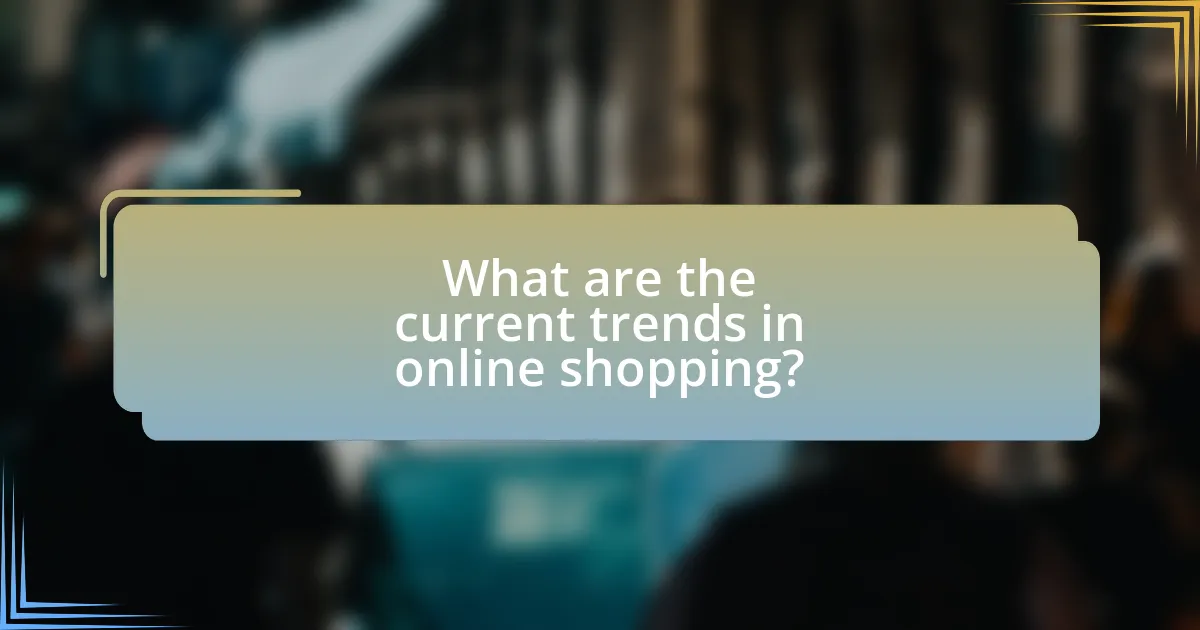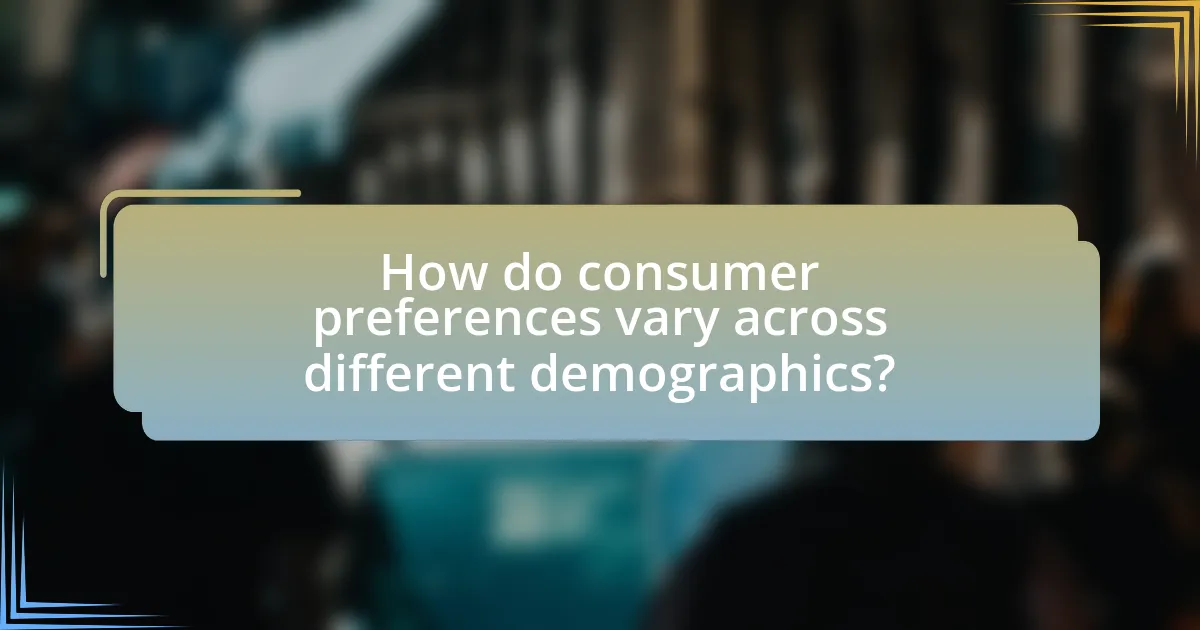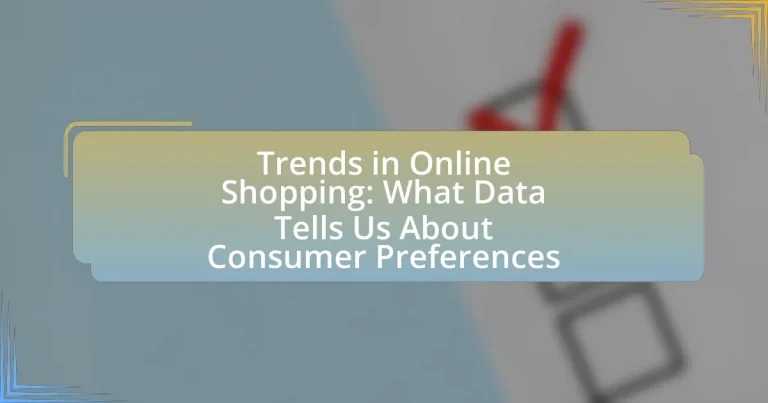The article focuses on current trends in online shopping, highlighting the significant rise of mobile commerce, personalized shopping experiences, and the influence of social media on consumer purchasing decisions. It examines how consumer preferences have shifted towards convenience, personalization, and sustainability, driven by technological advancements and changing demographics. The article also explores the impact of demographic factors, such as age and income, on online shopping behaviors, as well as the role of data analytics in understanding and predicting consumer preferences. Additionally, it discusses emerging trends in sustainable shopping practices and best practices for retailers to align with evolving consumer demands.

What are the current trends in online shopping?
Current trends in online shopping include the rise of mobile commerce, personalized shopping experiences, and the increasing use of social media for product discovery. Mobile commerce has grown significantly, with Statista reporting that mobile devices accounted for over 54% of global e-commerce sales in 2021. Personalized shopping experiences are driven by data analytics, allowing retailers to tailor recommendations and promotions to individual preferences, which enhances customer engagement and conversion rates. Additionally, social media platforms are becoming vital channels for e-commerce, with platforms like Instagram and Facebook integrating shopping features that enable users to purchase directly through their apps, reflecting a shift in consumer behavior towards social commerce.
How have consumer preferences shifted in recent years?
Consumer preferences have shifted towards online shopping, emphasizing convenience, personalization, and sustainability. Recent data indicates that 79% of consumers prefer to shop online for its ease and accessibility, reflecting a significant increase in e-commerce adoption, particularly during the COVID-19 pandemic. Additionally, 66% of consumers express a desire for personalized shopping experiences, driven by advancements in AI and data analytics that tailor recommendations to individual preferences. Furthermore, a growing awareness of environmental issues has led 73% of consumers to prioritize sustainable brands, influencing their purchasing decisions. These trends illustrate a clear evolution in consumer behavior, highlighting the importance of adapting to these preferences in the retail landscape.
What factors are influencing these shifts in preferences?
Shifts in consumer preferences in online shopping are influenced by technological advancements, changing demographics, and evolving consumer behaviors. Technological advancements, such as the rise of mobile shopping and personalized recommendations driven by artificial intelligence, enhance user experience and convenience, leading to increased online purchases. Changing demographics, particularly the growing influence of millennials and Gen Z, who prioritize sustainability and ethical practices, are reshaping demand for eco-friendly products. Additionally, evolving consumer behaviors, accelerated by the COVID-19 pandemic, have led to a greater emphasis on online shopping due to safety concerns and the convenience of home delivery. These factors collectively drive the ongoing shifts in consumer preferences in the online shopping landscape.
How do demographic changes impact online shopping trends?
Demographic changes significantly impact online shopping trends by influencing consumer preferences, purchasing power, and shopping behaviors. For instance, younger generations, such as Millennials and Gen Z, are more inclined to shop online due to their familiarity with technology and preference for convenience, leading to increased online sales. According to a report by Statista, in 2021, 54% of Gen Z consumers preferred online shopping over in-store shopping, highlighting a shift in shopping habits driven by age demographics. Additionally, as populations age, older consumers are increasingly adopting online shopping, with a 2020 AARP study indicating that 61% of adults aged 50 and older reported shopping online more frequently than before the pandemic. This demographic shift not only expands the online market but also necessitates retailers to adapt their strategies to cater to diverse age groups and preferences, ultimately shaping the future of e-commerce.
What role does technology play in shaping online shopping trends?
Technology significantly influences online shopping trends by enhancing user experience, streamlining transactions, and enabling personalized marketing. For instance, advancements in artificial intelligence and machine learning allow retailers to analyze consumer behavior, leading to tailored recommendations that increase conversion rates. According to a report by McKinsey, companies that leverage AI for personalization can see a 10-30% increase in sales. Additionally, mobile technology has transformed shopping habits, with Statista reporting that mobile commerce accounted for 54% of total e-commerce sales in 2021. This shift underscores how technology not only shapes consumer preferences but also drives the overall growth of the online shopping sector.
How are mobile devices changing the online shopping experience?
Mobile devices are transforming the online shopping experience by enabling seamless access to e-commerce platforms anytime and anywhere. This shift has led to increased consumer engagement, as studies show that over 50% of online shopping traffic now comes from mobile devices, according to Statista. Furthermore, mobile shopping applications enhance user experience through personalized recommendations and streamlined checkout processes, resulting in higher conversion rates. Research from Adobe indicates that mobile users tend to spend 50% more than desktop users during shopping sessions, highlighting the significant impact of mobile devices on consumer spending behavior.
What impact do social media platforms have on consumer purchasing decisions?
Social media platforms significantly influence consumer purchasing decisions by shaping brand perceptions and facilitating product discovery. Research indicates that 54% of social media users utilize these platforms to research products before making a purchase, highlighting their role in the decision-making process. Additionally, platforms like Instagram and Facebook drive impulse buying, with 30% of users reporting that they have made unplanned purchases due to content seen on these sites. This impact is further evidenced by the fact that 70% of consumers are more likely to purchase a product after seeing it on social media, demonstrating the platforms’ effectiveness in converting engagement into sales.
What are the emerging shopping behaviors among consumers?
Emerging shopping behaviors among consumers include increased preference for online shopping, a focus on sustainability, and the use of social media for product discovery. Data from a 2023 survey by McKinsey indicates that 70% of consumers now prefer to shop online due to convenience and a wider selection of products. Additionally, 60% of consumers are prioritizing sustainable brands, reflecting a growing awareness of environmental issues. Furthermore, a report by Statista shows that 50% of consumers use social media platforms to discover new products, highlighting the shift towards digital engagement in shopping.
How do subscription services affect consumer buying habits?
Subscription services significantly alter consumer buying habits by promoting convenience and fostering brand loyalty. These services often encourage consumers to make recurring purchases, which can lead to increased spending over time. For instance, a study by McKinsey & Company found that 15% of consumers have subscribed to at least one service, with many reporting that they spend more on subscription services than they would on traditional purchases. This shift is driven by the ease of automatic renewals and the perceived value of curated offerings, which can lead to a decrease in impulse buying and a more predictable spending pattern.
What is the significance of personalized shopping experiences?
Personalized shopping experiences significantly enhance customer satisfaction and loyalty. By tailoring recommendations and offers based on individual preferences and behaviors, retailers can create a more engaging shopping environment. Research indicates that 80% of consumers are more likely to make a purchase when brands offer personalized experiences, demonstrating the effectiveness of this approach in driving sales and fostering long-term relationships.

How do consumer preferences vary across different demographics?
Consumer preferences vary significantly across different demographics, influenced by factors such as age, income, gender, and geographic location. For instance, younger consumers, particularly millennials and Gen Z, tend to prioritize sustainability and brand ethics, with 73% of millennials willing to pay more for sustainable products, according to a 2021 Nielsen report. In contrast, older demographics, such as baby boomers, often focus on product quality and reliability, showing a preference for established brands. Additionally, income levels affect purchasing power and brand loyalty; higher-income consumers are more likely to invest in premium products, while lower-income groups may prioritize affordability and value. Geographic location also plays a role, as urban consumers often have different preferences compared to rural consumers, with urban shoppers favoring convenience and online shopping options. These variations highlight the importance of tailoring marketing strategies to meet the specific needs and preferences of diverse demographic groups.
What differences exist between age groups in online shopping?
Differences in online shopping between age groups primarily manifest in preferences, purchasing behavior, and technology usage. Younger consumers, particularly those aged 18-34, tend to favor mobile shopping and social media platforms for product discovery, with 54% of this demographic reporting that they use social media to influence their purchasing decisions, according to a 2022 survey by Statista. In contrast, older consumers, particularly those aged 55 and above, often prefer traditional websites and are more likely to prioritize security and ease of use, with 70% of this age group indicating that they value a straightforward shopping experience. Additionally, younger shoppers are more inclined to engage with brands through digital marketing channels, while older shoppers may rely more on email and direct promotions. These behavioral patterns highlight significant generational differences in online shopping habits.
How do millennials and Gen Z approach online shopping differently?
Millennials and Gen Z approach online shopping differently primarily in their preferences for brand engagement and technology use. Millennials tend to value brand loyalty and often seek out brands that align with their personal values, while Gen Z prioritizes authenticity and social media influence, frequently discovering products through platforms like TikTok and Instagram. According to a 2021 survey by McKinsey, 60% of Gen Z consumers prefer to shop online through social media channels, compared to 40% of millennials who still favor traditional e-commerce websites. This shift indicates that Gen Z is more inclined to engage with brands in a digital space that emphasizes community and peer recommendations.
What preferences do older generations have regarding online shopping?
Older generations prefer online shopping experiences that prioritize simplicity, security, and customer service. Research indicates that 70% of older adults value user-friendly websites that are easy to navigate, reflecting their desire for straightforward shopping processes. Additionally, they often seek secure payment options, with 65% expressing concerns about online security and privacy. Customer service is also crucial; studies show that 60% of older shoppers prefer retailers that offer accessible support, such as live chat or phone assistance, to address their inquiries promptly. These preferences highlight the importance of tailored online shopping experiences for older consumers.
How do gender and income levels influence online shopping choices?
Gender and income levels significantly influence online shopping choices, with distinct patterns observed among different demographics. Research indicates that women tend to prioritize product quality and brand reputation, while men often focus on price and functionality when making online purchases. Additionally, higher income levels correlate with increased spending on luxury items and premium brands, as individuals with greater financial resources are more likely to indulge in high-end products. Conversely, lower-income shoppers often seek discounts and value-for-money options, leading to a preference for budget-friendly brands and sales promotions. A study by the Pew Research Center found that 79% of women and 71% of men reported shopping online, highlighting the gender gap in preferences and spending habits. Furthermore, data from Statista shows that consumers with an annual income above $100,000 are more likely to spend over $1,000 annually on online shopping compared to those earning less than $30,000, who typically spend under $500. These insights illustrate how gender and income levels shape consumer behavior in the online shopping landscape.
What products are favored by different genders in online shopping?
Women tend to favor products such as clothing, beauty products, and home decor in online shopping, while men often prefer electronics, video games, and sports equipment. According to a 2021 report by Statista, 73% of women purchased clothing online, compared to 57% of men, while 65% of men bought electronics, in contrast to 45% of women. This data illustrates distinct gender preferences in online shopping, highlighting the differences in product categories favored by each gender.
How does income level affect spending habits in online shopping?
Income level significantly influences spending habits in online shopping, with higher-income individuals typically spending more on luxury and premium products. Research indicates that consumers with higher disposable income are more likely to engage in impulse buying and purchase higher-priced items, as they have greater financial flexibility. For instance, a study by the National Retail Federation found that households earning over $100,000 annually spent an average of 30% more on online shopping compared to those earning less than $50,000. This trend highlights that income level directly correlates with the types of products purchased and the overall spending behavior in the online marketplace.
What cultural factors impact online shopping preferences?
Cultural factors significantly impact online shopping preferences by influencing consumer behavior, values, and attitudes towards technology and commerce. For instance, collectivist cultures may prioritize group consensus and recommendations, leading to a preference for platforms that emphasize social proof and community feedback. In contrast, individualistic cultures often value personal choice and convenience, resulting in a higher inclination towards personalized shopping experiences and tailored recommendations. Additionally, cultural attitudes towards trust and security can affect online purchasing decisions; cultures with a high level of trust in digital transactions are more likely to engage in e-commerce. Research indicates that cultural dimensions, such as those outlined by Hofstede, play a crucial role in shaping these preferences, highlighting the importance of understanding cultural context in online retail strategies.
How do regional differences affect consumer behavior in online shopping?
Regional differences significantly influence consumer behavior in online shopping by affecting preferences, purchasing power, and cultural values. For instance, consumers in North America tend to prioritize convenience and fast shipping, often favoring retailers that offer same-day delivery options. In contrast, consumers in Europe may place a higher value on sustainability and ethical sourcing, leading them to support brands that emphasize eco-friendly practices. Additionally, a study by Statista in 2022 revealed that consumers in Asia-Pacific regions are more inclined to use mobile devices for shopping, with 70% of online purchases made via smartphones, compared to 50% in North America. These variations highlight how regional factors shape distinct shopping habits and preferences, ultimately impacting retailers’ strategies in different markets.
What role does language play in online shopping experiences?
Language plays a crucial role in online shopping experiences by influencing consumer understanding, engagement, and decision-making. Effective language enhances product descriptions, customer service interactions, and marketing communications, leading to improved user experience and higher conversion rates. Research indicates that 72% of consumers are more likely to purchase a product if the information is presented in their native language, highlighting the importance of language in building trust and facilitating comprehension. Additionally, personalized language tailored to consumer preferences can significantly increase customer satisfaction and loyalty, as it resonates more deeply with individual shoppers.

What insights can data provide about future online shopping trends?
Data can provide insights into future online shopping trends by revealing consumer behavior patterns, preferences, and emerging technologies. For instance, a report by Statista indicates that global e-commerce sales are projected to reach $6.39 trillion by 2024, highlighting a significant growth trajectory. Additionally, data analytics shows that personalized shopping experiences, driven by AI and machine learning, are increasingly influencing consumer decisions, with 80% of consumers more likely to make a purchase when brands offer personalized experiences. Furthermore, mobile commerce is expected to account for 72.9% of total e-commerce sales by 2021, indicating a shift towards mobile platforms. These insights suggest that businesses must adapt to evolving consumer preferences and technological advancements to remain competitive in the online shopping landscape.
How can businesses leverage data analytics to understand consumer preferences?
Businesses can leverage data analytics to understand consumer preferences by analyzing purchasing behavior, demographic data, and online interactions. By utilizing tools such as customer segmentation, predictive analytics, and sentiment analysis, companies can identify trends and patterns in consumer choices. For instance, a study by McKinsey & Company found that businesses using data-driven insights can improve their marketing effectiveness by up to 15-20%. This demonstrates that data analytics not only helps in tailoring products and services to meet consumer needs but also enhances customer satisfaction and loyalty.
What tools are available for analyzing online shopping data?
Tools available for analyzing online shopping data include Google Analytics, Tableau, and Adobe Analytics. Google Analytics provides insights into website traffic and user behavior, allowing businesses to track conversion rates and customer demographics. Tableau offers data visualization capabilities that help in interpreting complex datasets, making it easier to identify trends and patterns in consumer behavior. Adobe Analytics delivers advanced segmentation and real-time data analysis, enabling businesses to optimize their marketing strategies based on consumer preferences. These tools are widely used in the industry, with Google Analytics reporting over 29 million active users, demonstrating their effectiveness in analyzing online shopping data.
How can predictive analytics shape marketing strategies for online retailers?
Predictive analytics can significantly shape marketing strategies for online retailers by enabling data-driven decision-making that enhances customer targeting and personalization. By analyzing historical data, online retailers can identify patterns in consumer behavior, such as purchasing trends and preferences, which allows them to tailor marketing campaigns to specific customer segments. For instance, a study by McKinsey & Company found that companies using advanced analytics in their marketing strategies can achieve a 15-20% increase in sales. This data-driven approach not only improves customer engagement but also optimizes inventory management and pricing strategies, ultimately leading to increased profitability for online retailers.
What are the potential future trends in online shopping based on current data?
The potential future trends in online shopping include increased personalization, the rise of social commerce, and the integration of augmented reality (AR). Current data indicates that consumers increasingly prefer tailored shopping experiences, with 80% of shoppers more likely to purchase from brands that offer personalized experiences. Social commerce is gaining traction, as platforms like Instagram and TikTok facilitate direct shopping, with a projected growth rate of 25% annually. Additionally, the use of AR in online shopping is expected to enhance product visualization, with 61% of consumers preferring retailers that offer AR experiences, thereby improving engagement and conversion rates.
How might artificial intelligence influence future consumer preferences?
Artificial intelligence will significantly influence future consumer preferences by personalizing shopping experiences and enhancing decision-making processes. AI algorithms analyze vast amounts of consumer data to predict preferences, enabling tailored recommendations that align with individual tastes. For instance, a study by McKinsey & Company found that 35% of consumer purchasing decisions are influenced by personalized recommendations, showcasing the effectiveness of AI in shaping preferences. Additionally, AI-driven chatbots and virtual assistants improve customer service, leading to higher satisfaction and loyalty, which further impacts consumer choices.
What trends are expected to emerge in sustainable online shopping practices?
Emerging trends in sustainable online shopping practices include increased demand for eco-friendly products, enhanced transparency in supply chains, and the rise of circular economy models. Consumers are increasingly prioritizing sustainability, with a 2021 survey indicating that 66% of global consumers are willing to pay more for sustainable brands. Additionally, retailers are adopting technologies that provide detailed information about product sourcing and environmental impact, reflecting a growing expectation for transparency. The circular economy trend is also gaining traction, as businesses implement take-back programs and promote second-hand sales, aligning with consumer preferences for reducing waste and extending product life cycles.
What best practices can retailers adopt to align with consumer preferences?
Retailers can adopt personalized marketing strategies to align with consumer preferences. By utilizing data analytics, retailers can segment their customer base and tailor promotions, product recommendations, and content to individual preferences. For instance, a study by McKinsey & Company found that personalized experiences can lead to a 10-30% increase in sales. Additionally, retailers should enhance their omnichannel presence, ensuring a seamless shopping experience across online and offline platforms, as 73% of consumers prefer to shop through multiple channels. Implementing user-friendly interfaces and optimizing mobile shopping experiences are also crucial, given that mobile commerce is projected to account for 54% of total e-commerce sales by 2025.
How can retailers enhance the online shopping experience for consumers?
Retailers can enhance the online shopping experience for consumers by implementing personalized recommendations based on browsing and purchase history. Research indicates that 80% of consumers are more likely to make a purchase when brands offer personalized experiences, as highlighted in a study by Epsilon. Additionally, improving website navigation and ensuring mobile optimization can significantly reduce cart abandonment rates, which, according to Baymard Institute, average around 69.8%. Providing detailed product descriptions, high-quality images, and customer reviews further builds trust and aids decision-making, leading to higher conversion rates.
What strategies can businesses implement to stay ahead of consumer trends?
Businesses can implement data analytics and consumer feedback mechanisms to stay ahead of consumer trends. By leveraging data analytics, companies can identify purchasing patterns and preferences, allowing them to tailor their offerings accordingly. For instance, a report by McKinsey & Company highlights that businesses using advanced analytics can improve their marketing effectiveness by 15-20%. Additionally, actively seeking consumer feedback through surveys and social media engagement enables businesses to adapt quickly to changing preferences, ensuring they remain relevant in a competitive market.





